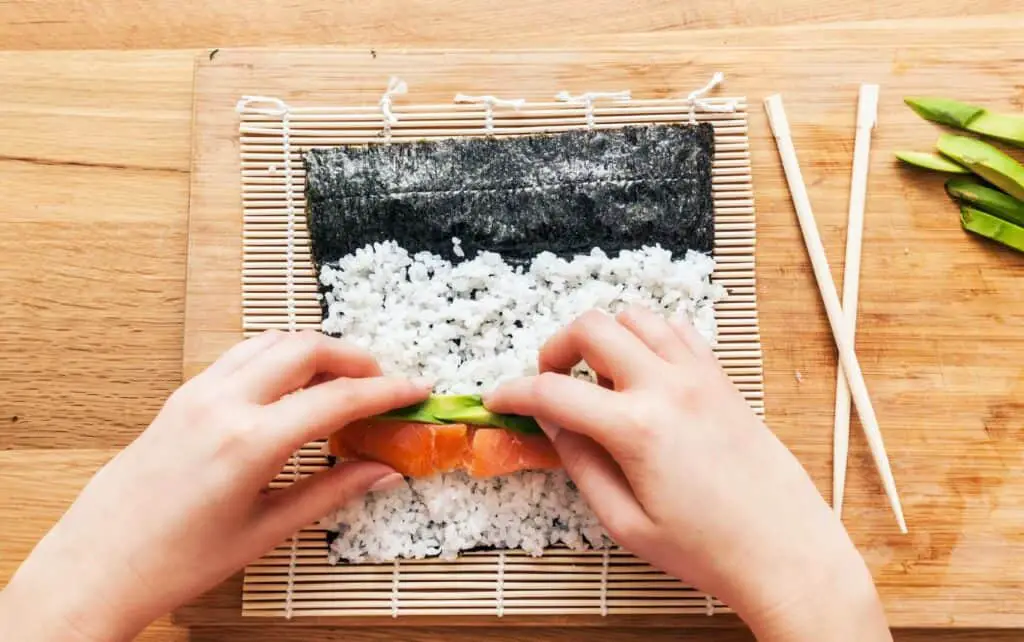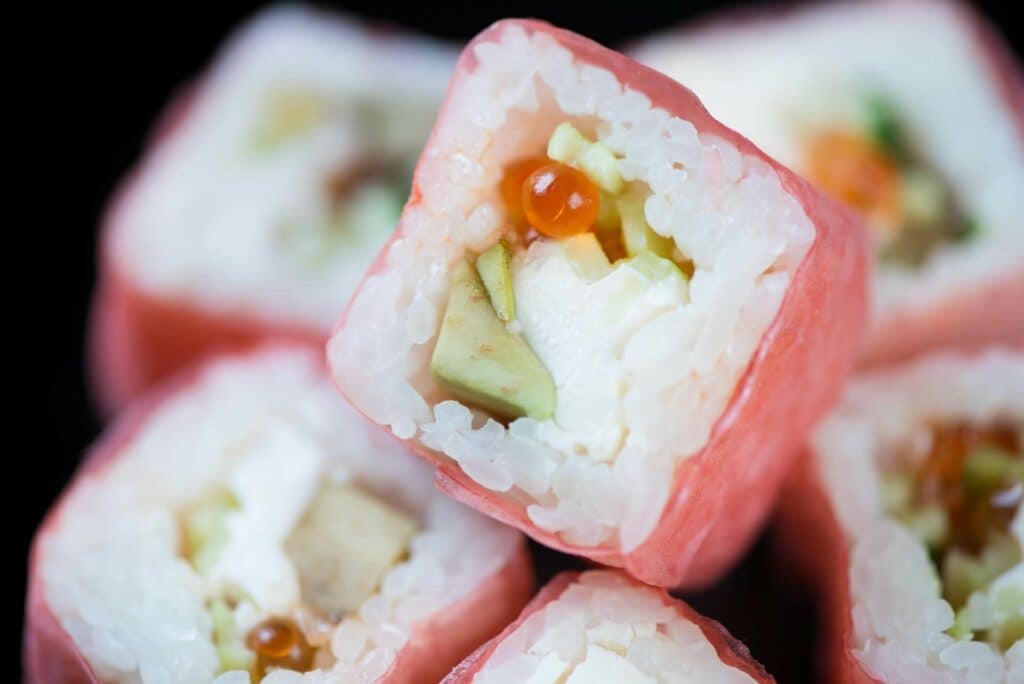Many consider seaweed to be an essential ingredient in every sushi. So, is it true? Does sushi have seaweed every time, or does it depend on the sushi type?
Yes, many types of sushi have seaweed, and traditional Japanese cuisine uses raw or toasted nori for this purpose. However, sushi kinds such as nigiri and inari are always made without it. For those who don’t enjoy nori taste, rice and soybean paper represent good alternatives.


Continue reading if you want to find out about nori and its alternatives, best seaweed wrapping techniques, seaweed-free sushi types, and much more.
Yes, Sushi Usually Does Have Seaweed
When thinking about sushi, most of us picture sushi rolls wrapped in thin slices of greenish-black seaweed. It’s not a coincidence – seaweed (typically nori), vinegared rice, and raw fish are all traditional sushi ingredients.
Its original purpose is to hold rice and other elements in place while complementing the sushi flavor. However, nowadays, especially in the States, the uramaki type (inside-out rolls), where rice is covering the seaweed, is even more prevalent.
All You Need to Know About Nori
Nori, and seaweed in general, is a famous component of Japanese cuisine, served with many delicious meals besides sushi – soups, salads, and dashi broth are just some of the delicacies in which seaweed is found. It holds many health benefits and has a unique, briny (umami) taste.
Just one nori sheet can be enough for one whole sushi roll, and it contains only 13 calories. Not only is it low in calories, but also high in vitamins, minerals, protein, and fiber. However, the strong taste and the ocean smell of seaweed may be repulsive to those who are much more used to Western-type food.
Fish, Seaweed, or Rice – What Makes Sushi Sushi?
It’s not raw fish or nori that is the main part of this dish – vegan and seaweed-free rolls are the proof of that. The central part of a sushi meal is vinegared sushi rice, whether you’re making maki, inari, uramaki, nigiri, temaki, or other types. Some of these are served without nori, and some don’t even contain raw fish, but vinegared rice is a common ingredient for them all. At the same time, it’s the main reason why sashimi isn’t considered sushi.
How to Use Nori When Making Sushi?
If you’re making homemade sushi with seaweed, here are steps you should follow to make it look perfect:
- Place nori on your bamboo mat, so its shiny side is facing down,
- Cover about three-quarters of nori with rice,
- Add vegetables, fish, and other ingredients to the bottom third of the nori,
- Bring up the back of the mat and roll it forward, but ensure you use your finger to hold the elements (all except thumbs which will roll the mat),
- Push the mat until the ends of nori meet and pull it tightly (make a shape of a roll or a square),
- Detach the mat, push it forward and continue rolling the same way until you reach the end of the seaweed,
- Slice the roll into smaller pieces, so they are all the same size,
- Serve.
Curious to know more about other Japanese delicacies? Read also :
Is Sushi Chinese Food?
Is Nigiri Sushi?
Can You Eat Sushi The Next Day?
What Is Tobiko?
Where To Buy Sashimi?
Is Sashimi Tuna?
Types of Sushi Made Without Seaweed
Sushi doesn’t need to have seaweed in order to be classified as such. The best example of that is nigiri. Although seaweed can be served in some cases in the form of ribbon (or belt) to hold the ingredients together, nigiri usually contains only an oval-shaped cluster of vinegared rice covered with thin slices of raw fish. Although maki (and uramaki) sushi is a more popular sushi type in the States, all lovers of Japanese food are familiar with nigiri taste.
Inarizushi Brings Something Different to the Table
Inari is a type of sushi made from vinegared rice and small deep-fried tofu pockets called aburaage. Two kinds of inarizushi, Tokyo-style and Osaka-style, hold different shapes and ingredients. Take a look at the table below to compare these inari types:
| Type | Shape | Rice covering | Ingredients |
| Tokyo-style inari | Straw bag-shaped | Rice is completely covered | Rice and tofu |
| Osaka-style inari | Straw bag, or triangle shaped | Rice is exposed at the bottom | Other, colorful ingredients can be added on top of the rice |
Can Makizushi (Sushi Rolls) Be Wrapped Without Seaweed? Best Alternatives to Nori
Sushi rolls, in general, need wrapping that helps everything stay in place – but that wrapping doesn’t have to be nori. If you’re not a big fan of the taste and the smell of seaweed, you’ll be happy to know that other excellent substitutes can be used.
Soybean paper is made from compressed soybeans, and in Japanese cuisine, it’s known as mamenori. It doesn’t bring as many health benefits as seaweed, but with low calories and carbs and no cholesterol or trans and saturated fat, it’s not an unhealthy substitute, either.
One advantage soybeans paper does have over nori is the variation of color it can provide. Unlike the always green nori, soy paper comes in orange, pink, yellow, and other interesting colors. Why not make your food even more fun?
As another nori alternative, you can also use rice paper – it basically has no taste, so it’s perfect when you want to emphasize the flavor of rice and other ingredients. In addition to that, making rolls with it is much easier – you don’t even need a mat.

Enjoy Each Sushi Type Just the Way You Like It
Whether you love the unique taste of seaweed or are not such a big fan of it, you can still enjoy the deliciousness of sushi – and that includes more than nigiri and inari. Philadelphia, Boston, and California rolls are only some of many sushi kinds that can be made both with nori and other wrappers. Make sure you try these when you get the chance – you won’t regret it.